Firefighter, 56, believes job triggered cancer as report reveals disease is more common among first-responders

A firefighter who overcame head and neck cancer blames the diagnosis on his profession.
Sid McNally, 56, saw a GP after his wife noticed a lump on his neck in 2012.
While removing the lump, a specialist spotted McNally had slight discolouration at the base of his tongue, where the cancer is thought to have originated.
McNally – a non-smoker – was asked how many cigarettes he got through a day, assuming that triggered the disease.
The firefighter, who now trains recruits, beat cancer after six weeks of chemotherapy and radiotherapy.
McNally is convinced insufficient protective gear at the start of his career brought on the disease, with the same cancer killing his friend and fellow-firefighter Steve Peacher, who also did not smoke.
Read more: Vitamin D may ward off advanced cancer
This comes after scientists from the University of Central Lancashire found cancer is around four times more common among firefighters than the general population.
Fires are said to produce a cocktail of toxic chemicals, however, preventative measures can help cut the risk.

“I feel I was lucky as my cancer was identified at an early stage,” said McNally.
Read more: Brain cancer patient forced to fundraise for treatment
“With chemo and radiotherapy treatment, I managed to return to work in just over six months.
“Sadly my mate Steve, who I’d served with on the same watch for three years, did not survive.”
‘I had no concerns whatsoever’
McNally joined the Essex County Fire and Rescue Service in January 1995.
Seventeen years later, his paramedic wife noticed he had a lump on his neck.
McNally put off going to the GP for several weeks, assuming it was nothing to worry about.
“I had no worries, no concerns whatsoever,” he told Yahoo UK.
“I’ve had a couple of lumps removed in the past and had no issues.”
The GP eventually referred McNally for a biopsy, with surgeons opting to remove the lump.
The same consultant also treated McNally’s friend Peacher and knew to look at the back of the firefighter’s tongue for any other signs of cancer.
“It was discoloured; about the size of a five-pence piece at the base of the tongue,” said McNally.
Read more: Leukaemia patient infectious with coronavirus for at least 70 days
Doctors diagnosed McNally with a tumour at the base of the tongue, a type of head and neck cancer, which spread.
After the chemotherapy-radiotherapy regimen ended, McNally endured a loss of taste.
Eight years on, the damage to his salivary gland still leaves him with a dry mouth.
“I can’t eat chips or bread,” said McNally. “I can’t swallow it.”
After overcoming the disease, McNally had check-ups around every three months, which were gradually reduced to once every six months and then annually.
The firefighter was conscious other people needed his doctor’s time, so chose to stop the regular check-ups and let the medic know if he felt any new lumps.

With no family history of head and neck cancer, McNally puts his disease’s onset down to his job.
“There were no control measures when I first joined in 1995,” he said.
“We didn’t put BA [breathing apparatus] on.
Read more: Month delay to cancer treatment raises death risk by up to 13%
“We used to breathe it in and go home smelling of smoke.
“If you didn’t have a cough and a splutter you weren’t half the man they thought you’d be.
“Nowadays there are a lot more precautions and my station definitely overcame that badge of honour culture where we were proud of our dirty kit.”
‘The risk doesn’t stop when the fire has been extinguished’
The Lancaster scientists surveyed more than 10,000 firefighters across the UK.
Just under one in 20 (4.1%) had already been diagnosed with cancer.
Among the general population, 50% of people in the UK will statistically develop the disease at some point in their life, however, less than 1% were diagnosed in 2017.
Of the firefighters who developed cancer, three-quarters had served for at least 10 years before being diagnosed.
Cancer becomes more common with age, however, over half the firefighters who had cancer were diagnosed under 50, while a fifth were under 40.
Skin cancer was the most common form of the disease, affecting just over a quarter (26%) of the firefighters, followed by testicular cancer (10%), and head and neck cancer (4%).
In most US and Canadian states, legislation recognises certain cancers as occupational diseases among firefighters.
UK officials have so far concluded there is insufficient evidence to link fire exposure to the disease.
“Firefighters risk their lives every day to keep their communities safe, but it’s clear the risk to their health doesn’t stop when the fire has been extinguished,” said Matt Wrack from the Fire Brigades Union, which commissioned the study.
“Sadly we often see serving and former firefighters suffer from cancer and other illnesses.”
The Lancaster scientists have put together some best practices to minimise a firefighter’s risk, like regular training, respiratory protective equipment being worn at all times and showering within an hour of returning home from a call out.
“These recommendations are vital if we are to improve firefighters’ health and well-being, keep them safe and prevent exposure to toxic chemicals, which can lead to life-changing problems or premature death,” said study author Professor Anna Stec.
Watch: Raising awareness of cancer and PTSD among firefighters


